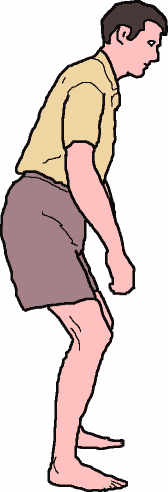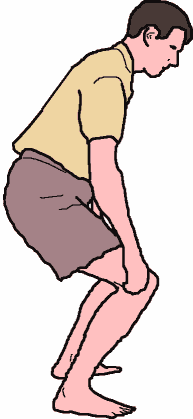|
|
|---|
Read the contraindications before proceeding!
Full Squat: Start Position
- Stand in the "position of mechanical advantage".
- Pelvic neutral and scapulas gently anchored.
- Let your neck and shoulders relax and arms hang loose.
Full Squat: Action
- Breathe in, zip and hollow and engage the Gluteus maximus.
- (Breathing out): Lower until knees are bent to 90 degrees, (less if you have pain) & pause.
- Reach the hips to the back wall
- Breathe in, and (breathing out): Lower as far as you comfortably can
without your heelseet leaving the ground.
- If you can get all the way down, relax and imagine you are tying the shoe lace of a toddler!
- To rise, breathe in then exhale to stand.
Once you can confidently full squat, dispense with step 2,3 & lower in one continuous movement.
Stretching the gluteal and calf muscles: remain in the squat position for 1 to 5 minutes.
Exercise of back muscles, Quads, Gluteus & calves: 5 slow repeats without pausing.
You may go down only as far as the half squat.
(full squat exercise further instructions, benefits, contraindications, Scroll right>>...)
|
The Illustrated Full Squat:-
|
|
Start of Squat:-
 |
Note:
the mid squat is a very safe exercise.
Mid Squat:-
 |
Contraindications:
Don't deep squat if you have damage of
knee cartilage, knee cap, or posterior cruciate ligament(5).
Full Squat:-
 |
|
Watch Points for the Full Squat:-
- If you have a tight muscle on one side, you will find that your weight is
tending to shift over to the less stiff side. Don't let this happen.
- At no time during the descent or ascent should the knee drop inside your second toe.
- Your head does not look upward, but rather remains in alignment with your spine.
Only your eyes should look upward.
illustrated full squat© Bruce Thomson, EasyVigour Project
(scroll up^^^^.....)
|
Benefits of Squatting:-
- The full squat re-educates your body to do what you did naturally as a child:
bend at the hips before bending at the lower back and neck(1,2,3).
- The full squat uses almost all the muscles in your body and
improves sport specific performance (jumping, sprinting and long distance running)(5).
- Improves pumping of body fluids, movement of faeces through the colon,
encourages parasympathetic nervous activity (relaxation and digestion as opposed to "fight and flight")(4).
- Can be performed anywhere, anytime.
If they can full squat, you can full squat! -
(though it may take a few months of practice!)
Reference
|

|
- Wilfred Barlow: "The Alexander Principle" Arrow Books Ltd. Reprinted 1987 ISBN 0 09 910160 2
- Bruce Thomson: Engage Gluteus maximus!
- Wayne Milicich: "Move like a Child": Publ. Optimum Publishing Limited. Hamilton New Zealand.
- Paul Chek:
http://www.mercola.com/2004/jul/
31/fear_the_squat.htm
- Peak performance Online: http://www.pponline.co.uk/encyc/squat.html
|



